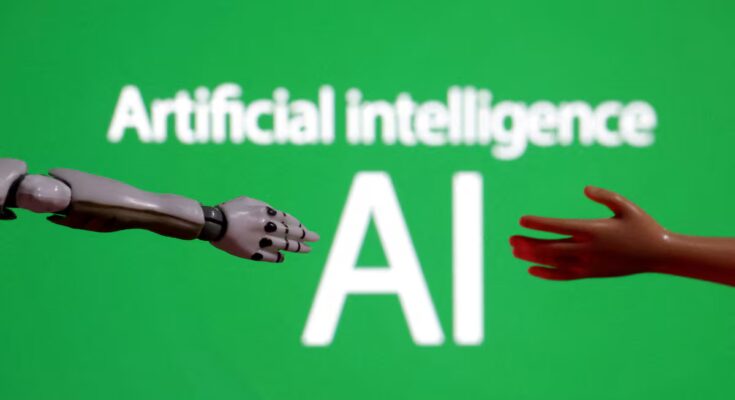The revolution of the so-called hyperscalers is taking on increasingly colossal proportions. The commitment of technology companies to artificial intelligence is measured in hundreds of billions of euros, investments that until recently came exclusively from stratospheric, but finite, profits. The sector needs even more data centers and, to finance them, it has begun to knock on the door of the debt market, awakening investors’ doubts and cooling the market’s love for technologies. Oracle, the most indebted of the large companies and which has entrusted its future to the contracts signed with OpenAI, is at the center of all doubts: its shares have fallen by 33% compared to the September high. The punishment also reaches its debt, which trades below par value, while default insurance on its bonds – a gauge of its financial risk – rises to levels not seen in three years, dragging down those of other companies with high AI exposure and worse credit history.
The market predicts a debt crisis and has remained on guard; Paying for investments based on million-dollar profits is not the same as borrowing money. According to JP Morgan’s calculations, building the global data center and AI infrastructure, along with the necessary energy supplies, will cost more than $5 trillion between now and 2030. Of that amount, only $1.5 trillion will come from companies’ organic cash flow; For the rest, large technology companies will need to approach the window of the capital markets. “It will be an extraordinary and long-lasting event on the capital markets,” sums up the entity.
The bank estimates that over the next five years the large technology companies exposed to artificial intelligence – Alphabet, Amazon, Microsoft, Meta and Oracle – will have to issue bonds for 1.5 trillion dollars, and that in 2026 alone they will place 300,000 million, more than half of what the US Treasury issues. USA by 2030,” he points out in a report.
For now, between September and October alone, the tech giants have raised $75 billion in investment grade bonds, and are expected to close out the year by raising more than $200 billion in debt, between private placements (made to venture capital funds with less transparency) and in the market. All this to cover investments to create infrastructure related to artificial intelligence worth 380 billion dollars.
Oracle and Meta have so far been the companies that have deployed the greatest capacity to finance their artificial intelligence strategy, followed by Alphabet (despite Google’s parent company having 100 billion in liquidity). This kicked off May with the issuance of $11 billion, and Oracle swooped in with $15,000 million in September, with record demand. From there, Meta raised $30 billion in bonds in October and raised another $27,000 in the private market to finance a data center in Louisiana (USA). In this case, through a special purpose vehicle (SPV), which allows a company to finance a specific project without this debt entering its balance sheet.
This avalanche has led UBS to raise “concentration risk concerns,” as the problems are spread across a handful of stocks: Meta, Oracle, Alphabet, Broadcom and Dell. The emissions differentials of some of these companies are already increasing. And banks are handing out to these companies an arsenal of exotic financial engineering tools: bonds backed by data center mortgages, securitized debt ABS (asset-backed securities)… Bank of America estimates that the data center securitization market will reach $110 billion next year.
Growing investments and doubts about profitability
Meta founder Mark Zuckerberg revealed that the company will invest approximately $600 billion in AI-related infrastructure in the United States alone; In 2025 alone there will be 71,000, a figure that is expected to almost double in 2027. For now it has room: even if it plans to multiply its debt 14 times in this period (from 4,000 to 59,000 million). Now, that will come at the expense of its share repurchase programs – $35 billion to $5 billion – and will reduce free cash flow by less than half.
Oracle’s commitment to artificial intelligence, stemming from its deal with OpenAI, has made it the most indebted investment grade technology company in just a few quarters and the only one with negative cash flow. While JP Morgan stresses that its maturities are manageable, it cautions against the backdrop of rising interest rates and large investment commitments ahead. Added to this is the pressure on its revenues: a third will depend on a single customer, OpenAI, by 2028. A scenario that leads Barclays to believe that the rating agencies will lower Oracle’s rating to BBB– (S&P and Moody’s have already placed a negative outlook), one step away from junk bonds, to the point of predicting that they will have to end up on the private debt markets – less transparent and more expensive -. The British bank even goes so far as to recommend the purchase of insurance against non-payment of the technology company, a signal that the market received with an increase in prices. credit default swaps (CDS) from Oracle. Bondholders record losses of up to 7% in just over a month and a half.
This instability is felt in other tech companies with exposure to AI but worse credit histories, but not among large hyperscalers, who remain oblivious. Shares of Coreweave, backed by Nvidia and with related contracts with Meta, have fallen 30% on the stock market in the past week and five-year CDS on its bonds have risen 13% in the same period.
On top of all this, JP Morgan wonders whether these huge investments will translate into real profitability. According to the report, to achieve a 10% return on all necessary investments over the next five years, large technology companies would have to record annual revenues of 650,000 million per year in perpetuity. “An incredibly large sum,” he points out, which translated into more tangible numbers equates to $180 per month for each Netflix user or $34.72 for each current iPhone owner. “Hopefully, there will be (and will continue to be) spectacular winners, and probably equally spectacular losers,” he adds.
Adding to the doubts about its profitability is the possible systemic impact of AI on the market: the Bank of England recently recognized that if until now its possible systemic impact on the market had been limited because it was concentrated on the strong revaluation of these companies on the stock exchange, their high need for financing could have an impact on the debt market and the commodity market, due to the high consumption of copper.



